

The Digital Future is Now: A Call to Action for the Humanities. Alliance of Digital Humanities Organizations 2009 Alliance of Digital Humanities Organizations. (2009).
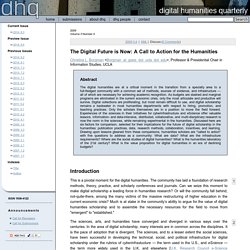
Retrieved from on 16 August 2009. Anderson 2004 Anderson, I. (2004). "Are you being served? Historians and the search for primary sources". Archivaria, 58: 81-129. ArXiv.org 2009 ArXiv.org e-Print archive. (2009). Arzberger et al. 2004 Arzberger, P., Schroeder, P., Beaulieu, A., Bowker, G. Atkins et al. 2003 Atkins, D. Atkins et al 2007 Atkins, D. The Martha Berry Digital Archive Project: A Case Study in Experimental pEDagogy. By Stephanie A.
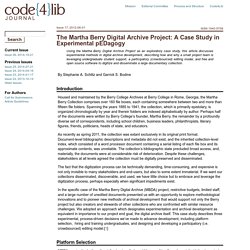
Schlitz and Garrick S. Bodine Introduction Housed and maintained by the Berry College Archives at Berry College in Rome, Georgia, the Martha Berry Collection comprises over 160 file boxes, each containing somewhere between two and more than fifteen file folders. Spanning the years 1885 to 1941, the collection, which is primarily epistolary, is organized chronologically by year and therein folders are indexed alphabetically by author. As recently as spring 2011, the collection was extant exclusively in its original print format. A Video Digital Library to Support Physicians’ Decision-making About Autism. By Matthew A.

Griffin, MLIS, Dan Albertson, Ph.D., and Angela B. Barber, Ph.D. Introduction A prototype video digital library was developed as part of a partnership between primary care medical clinics and the University of Alabama, a project funded by the National Network of Libraries of Medicine, Southeastern/Atlantic Region (NNLM SEA). This article summarizes the current functionality of a prototype video digital library aimed at supporting physicians treating potential autism cases and describes the developmental processes and implemented system components. Caregivers of children who fail an autism screener at the primary care clinics partnering with this project may be asked if trained staff at the clinic can conduct a video-recorded structured play-sample for further analysis at the University of Alabama Autism Spectrum Disorders (ASD) Clinic. Key Innovations of Video Digital Library. Developing a Digital Video Library with the YouTube Data API.
By Jason Clark Introduction With the maturation of web services giving rise to a stable development platform, Montana State University (MSU) Library decided to build a digital video library with YouTube as the data store and app engine.
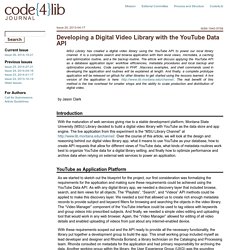
The live application from this experiment is the “MSU Library Channel” at Over the course of this article, we will look at the design and reasoning behind our digital video library app, what it means to use YouTube as your database, how to create API requests that allow for different views of YouTube data, what kinds of metadata routines work best to organize YouTube data for a digital library setting, and finally how to optimize performance and archive data when relying on external web services to power an application. YouTube as Application Platform With these requirements scoped out and the API ready to provide all the necessary functionality, the library put together a development group to build the app.
Figure 1. Figure 2. Metadata Standards. Breaking Up With CONTENTdm: Why and How One Institution Took the Leap to Open Source. By Heather Gilbert and Tyler Mobley Introduction In 2009 the College of Charleston, with support from the Gaylord and Dorothy Donnelley Foundation, built the Lowcountry Digital Library (LCDL), the first digital library in the Lowcountry region of South Carolina.
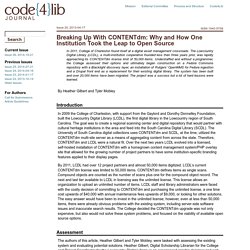
The goal was to create a regional scanning center and digital repository that would partner with cultural heritage institutions in the area and feed into the South Carolina Digital Library (SCDL). The University of South Carolina digital collections uses CONTENTdm and SCDL, at the time, utilized the CONTENTdm multi-site server as a means of aggregating content from across the state. Metadata In, Library Out. A Simple, Robust Digital Library System. By Tonio Loewald and Jody DeRidder, University of Alabama At the University of Alabama, we have developed a simple, robust digital library system using PHP, MySQL, and Apache.
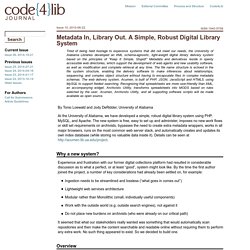
The new system is free, easy to set up and administer, imposes no new work flows or skill set requirements on archivists, bypasses the need to create extra metadata wrappers, works in all major browsers, runs on the most common web server stack, and automatically creates and updates its own index database (while storing no valuable data inside it). Details can be seen at. Variations2. How Do We Show You What We've Got? Access to Archival Collections in the Digital Age. Kate Cruikshank Political Papers Specialist The Lilly Library Indiana University cruiksha@indiana.edu Caroline Daniels Automated Systems Archivist University Archives and Record Center.
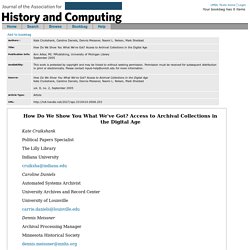
Quick tips on giving research presentations - Statistical Modeling, Causal Inference, and Social Science Statistical Modeling, Causal Inference, and Social Science. Hi, I’m writing this so I can refer to it when covering “giving a presentation” in my statistical communication class.
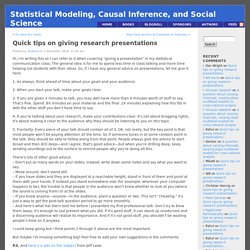
The general idea is for me to spend less time in class talking and more time helping out students with their ideas. Tobaccoeval.ucdavis.edu/documents/Tips_Tools_18_2012.pdf. Qualitative Coding & Analysis. .pdf version of this page This review is in the form of an abbreviated set of directions for initial coding and analysis.

There are many ways to accomplish both actions. This approach assumes you are using interview data. For a more detailed treatment of these and related analysis concepts, click here. Coding (social sciences) Coding is an analytical process in which data, in both quantitative form (such as questionnaires results) or qualitative (such as interview transcripts) is categorised to facilitate analysis.
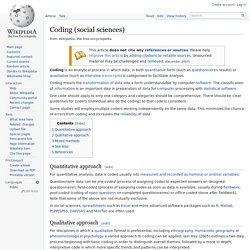
Coding means the transformation of data into a form understandable by computer software. The classification of information is an important step in preparation of data for computer processing with statistical software. One code should apply to only one category and categories should be comprehensive. Life With and Without Coding: Two Methods for Early-Stage Data Analysis in Qualitative Research Aiming at Causal Explanations. Volume 14, No. 2, Art. 5 – May 2013 Life With and Without Coding: Two Methods for Early-Stage Data Analysis in Qualitative Research Aiming at Causal Explanations Jochen Gläser & Grit Laudel Abstract: Qualitative research aimed at "mechanismic" explanations poses specific challenges to qualitative data analysis because it must integrate existing theory with patterns identified in the data.
The Digital Future is Now: A Call to Action for the Humanities.